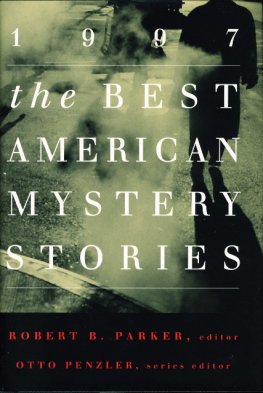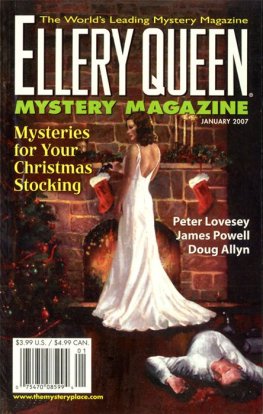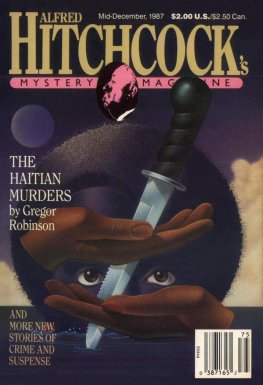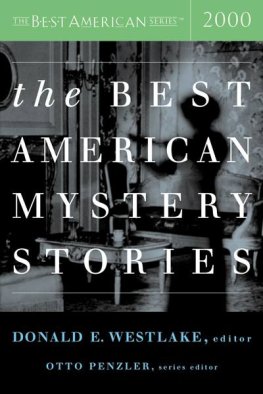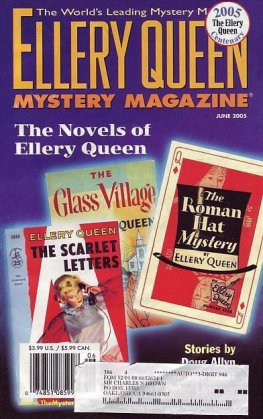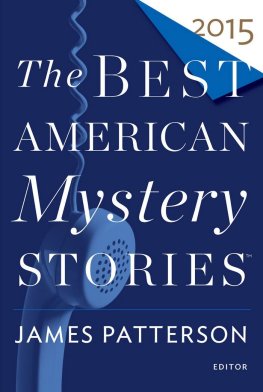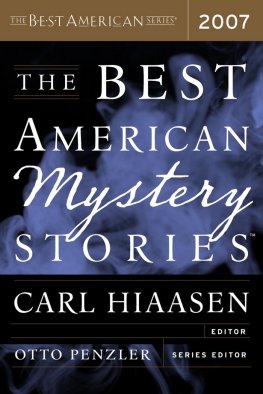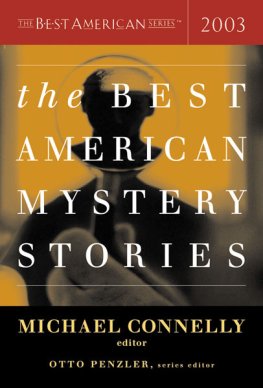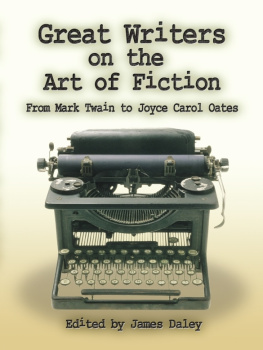The Best American Mystery Stories 1997
Blind Lemon by Doug Allyn. First published in Alfred Hitchcock Mystery Magazine. Copyright 1996 by Doug Allyn. Reprinted by permission of the author.
Hot Springs by James Crumley. First published in the collection Murder for Love. Copyright 1996 by James Crumley. Reprinted by permission of the author.
The Weekender by Jeffery Deaver. First published in Alfred Hitchcock Mystery Magazine. Copyright 1996 by Jeffery Deaver. Reprinted by permission of the author.
The Dark Snow by Brendan DuBois. First published in Playboy. Copyright 1996 by Brendan DuBois. Reprinted by permission of the author.
The Surprise of His Life by Elizabeth George. First published in the collection Women on the Case. Copyright 1996 by Elizabeth George. Reprinted by permission of the author.
Eyes That Never Meet by Jeremiah Healy. First published in the collection Unusual Suspects. Copyright 1996 by Jeremiah Healy. Reprinted by permission of the author.
Another Tented Evening by Melodie Johnson Howe. First published in Ellery Queens Mystery Magazine. Copyright 1996 by Melodie Johnson Howe. Reprinted by permission of the author.
The Mark by Pat Jordan. First published in Playboy. Copyright 1996 by Pat Jordan. Reprinted by permission of the author.
The Things We Do for Love by Jonathan Kellerman. First published in the collection Murder for Love. Copyright 1996 by Jonathan Kellerman. Reprinted by permission of the author.
Lou Monahan, County Prosecutor by Andrew Klavan. First published in the collection Guilty as Charged. Copyright 1996 by Andrew Klavan. Reprinted by permission of the author.
Karen Makes Out by Elmore Leonard. First published in the collection Murder for Love. Copyright 1996 by Elmore Leonard. Reprinted by permission of the author.
Red Clay by Michael Malone. First published in the collection Murder for Love Copyright by Michael Malone. Reprinted by permission of the author.
Mrs. Feeley Is Quite Mad by Mabel Maney. First published in the collection Out for More Blood: Tales of Malice and Retaliation by Women. Copyright 1996 by Mabel Maney Reprinted by permission of the author.
Will You Always Love Me? by Joyce Carol Oates. First published in Story Copyright 1996 by Joyce Carol Oates. Reprinted by permission of the author.
When Youre Hungry by George Pelecanos. First published in the collection Unusual Suspects. Copyright 1996 by George Pelecanos. Reprinted by permission of the author.
Hoops by S. J. Rozan. First published in Ellery Queens Mystery Magazine. Copyright 1996 by S. J. Rozan. Reprinted by permission of the author.
Doblins Lecture by Allen Steele. First published in Pirate Writings. Copyright 1996 by Allen Steele. Reprinted by permission of the author.
Kindred Spirits by Brad Watson. First published in the collection Last Days of the Dog-Men. Copyright 1996 by Brad Watson. Reprinted by permission of the author.
There Are Monsterim by John Weisman. First published in the collection Unusual Suspects. Copyright 1996 by John Weisman. Reprinted by permission of the author.
Unlawful Contact by Monica Wood. First published in Manoa. Copyright 1996 by Monica Wood. Reprinted by permission of the author.
The natural form for the traditional mystery is not the novel but the short story. It is not uncommon for a detective story to revolve around a single significant clue which can be discovered, divulged, and its importance explained in a few pages. The rest is embellishment.
Mystery fiction has changed a great deal in recent years, as have virtually all art forms. The classic tale of a murder being committed, the local police called in and responding with utter bafflement, the gifted amateur offering assistance, discovering new clues, breaking down old alibis, and finally identifying the least likely suspect is largely a thing of the past.
Nowadays, much more is expected of the mystery novel, and even of the short story. We have come to expect the same depth of characterization that we do from general fiction, the same sort of intelligent and/or amusing dialogue, the same door opening to let us into a previously unknown or unexplored world. But we also expect a carefully constructed story line that rewards our close attention with a realistic conclusion that answers all the questions posed along the way. No loose ends in these stories; no unexplained activities.
The mystery is the last literary form where serious writers can demonstrate their gifts to provide a thoughtful profile of an individual in the context of society while still being required to plot meticulously. It is the last place a serious reader can have confidence that a literary exercise will also provide a fun, satisfying experience.
Houghton Mifflin, having published the prestigious series Best American Short Stories, has this year decided to offer serious readers a new volume, The Best American Mystery Stories, which is planned as an annual event.
The methodology for compiling this volume is similar to that used for The Best American Short Stories. As the series editor, it is my responsibility to identify and read all the mystery stories published in the calendar year (for this first collection, in the year 1996). From this large number (approximately 500) the goal was to select the best fifty stories and pass them along to the guest editor, who would then choose the best twenty for publication, the others receiving honorable mention.
The source for these stories is, of course, wherever original fiction is published. The most fruitful sources are the mystery specialty magazines, small literary journals, popular consumer publications, and an unusually bountiful crop from anthologies containing all or some original work.
Many editors of non-mystery magazines claimed they didnt publish mystery stories until I provided the definition that has served throughout my varied career in the mystery world. I defined a mystery story as any in which a crime, or the threat of a crime, is central to the theme. Crimes against an individual count, naturally; most frequently murder but also kidnapping, rape, robber}, stalking, or whatever other illegal activity violates another human being. Crimes against the state also fall into my definition, including espionage, terrorism, and whatever other acts directed against a government ultimately do damage to its citizens.
Because of this loose (I prefer to think of it as generously accepting) definition of a mystery, the stories collected here are enormously diverse. Some are traditional detective stories; others are crime tales, which have become increasingly popular in recent times. Some are as slim and tight as youd expect from the notion of a short story. Others, like Michael Malones Red Clay, James Crumleys Hot Springs, and S. J. Rozans Hoops, are deep enough to be expanded to novels. Two of those have already been optioned for movies. Elmore Leonard liked his female protagonist (and a couple of minor characters) so much that he wrote a novel around them.
As is true of all distinguished literature, some of these stories will linger in the memory for a time, sometimes perhaps even a long time. By the time the last of them fades, it will be time for the 1998 volume of The Best American Mystery Stories.
Editors, publishers, and authors who want to be assured that their stories will be considered for the next volume in this series should send material to Otto Penzler, The Mysterious Bookshop. 129 West 56th Street, New York, NY 10019.
O. P.
Whoever wrote the first mystery (Job?), Arthur Conan Doyles invention of Sherlock Holmes created the category. And when American stories about detectives appeared, the category was there to receive them, even though their ancestry is rather different. The unstated, perhaps even unthought assumptions about life that underlie the Holmes stories are that a rational God created a reasonable world. His will is manifest in His creation. Crime is an unreasonable deviation from the norm, and a man of superior reason can restore the norm by solving the crime. It is a triumph of intelligence, smaller in scope but not different in kind from the triumph of intelligence that contrived the original creation. The detectives success is a restoration of the grand design. Since Gods will is manifest in His creation, that is to say, nature, then one can understand His will by studying nature. Thus at heart the kind of story that Dr. Doyle was writing celebrates the triumph of science (the rational examination of evidence), which in Dr. Doyles time seemed well worth celebrating. The kind of story that posits such a universe and such a triumph is often called the English (or ratiocinative) detective story, and the designation is useful enough as long as we know that Americans write that kind of story as well, and that many English writers dont.

